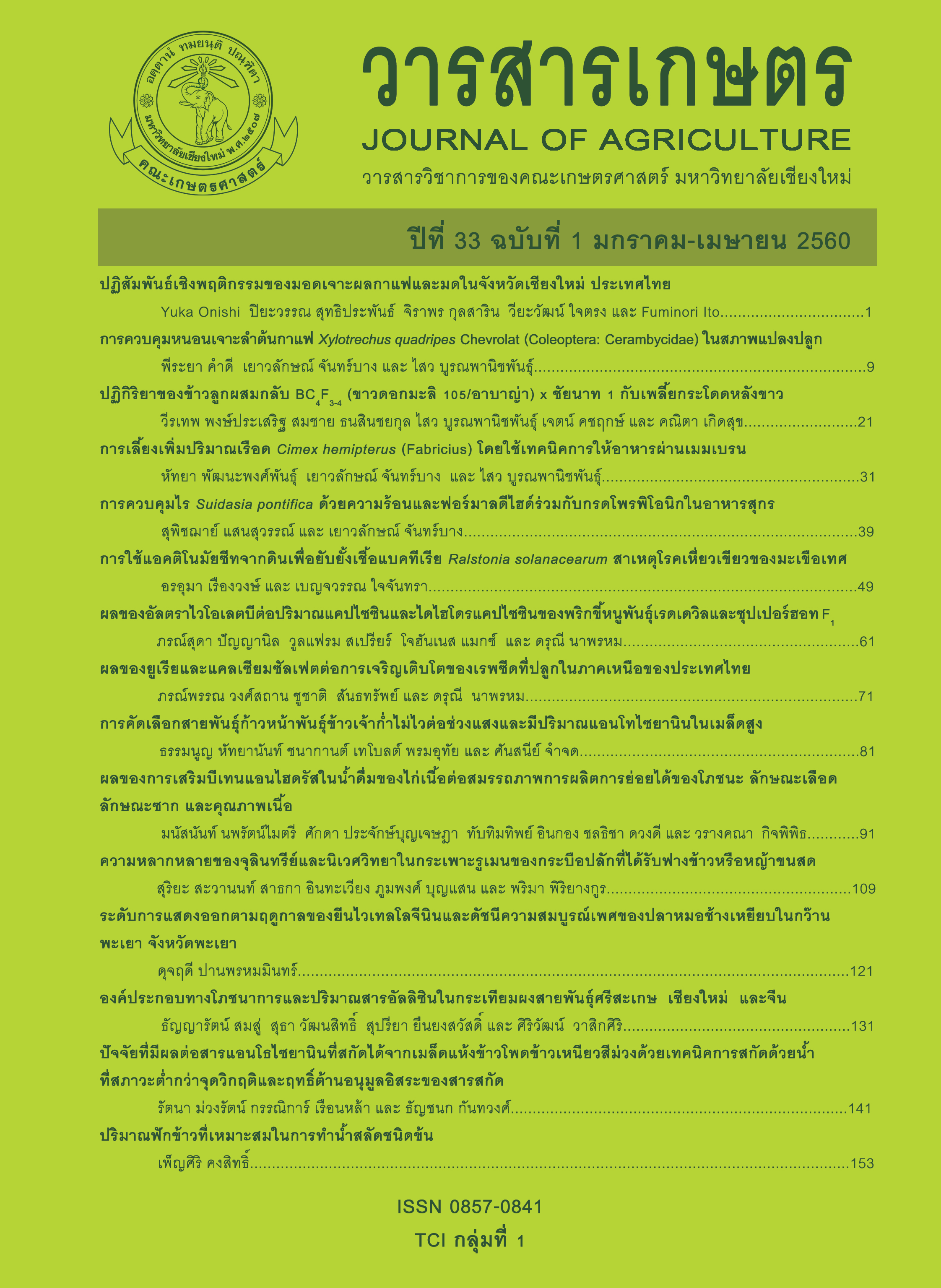ปฏิสัมพันธ์เชิงพฤติกรรมของมอดเจาะผลกาแฟและมดในจังหวัดเชียงใหม่ ประเทศไทย
Main Article Content
บทคัดย่อ
The behavioral response of ants to the adult of coffee berry borer (CBB) was studied in laboratory condition. The observed ants were seven dominant ant species collected from coffee plantations in northern Thailand i.e. Anoplolepis gracilipes, Camponotus nicobarensis, Crematogaster sp. PM2, Dolichoderus sp. PM1, Tapinoma sp. PM1, Technomyrmex modiglianii and Technomyrmex yamanei. The following ant behaviors against CBB were recorded in the laboratory: 1) Antennal contacting, 2) Attacking, and 3) Carrying. All species attacked CBB and some the species also carried the CBB. However, no ant species fed on the CBB. The CBB got damaged if ants intensively attacked or if they were grasped for carrying. A. gracilipes and C. nicobarensis were less aggressive against CBB, while Dolichoderus sp. PM1 and Tapinoma sp. PM1 seemed to be the more effective biological control agents for CBB.
Article Details
เอกสารอ้างอิง
Buranapanichpan, A. and Y. Chanbang. 2014. Infestation of coffee berry borer and controlling efficiency of attractants. Journal of Agriculture 30(3): 223-231.
De la Mora, A., G. Pérez-Lachaud and J.P. Lachaud. 2008. Mandible strike: the lethal weapon of Odontomachus opaciventris against small prey. Behavioural Processes 78(1): 64-75.
Gonthier, D.J., K.K. Ennis, S.M. Philpott, J. Vandermeer and I. Perfecto. 2013. Ants defend coffee from berry borer colonization. BioControl 58(6): 815-820.
Jaramillo, J., E. Muchugu, F.E. Vega, A. Davis, C. Borgemeister and A. Chabi-Olaye. 2011. Some like it hot: the influence and implications of climate change on coffee berry borer (Hypothenemus hampei) and coffee production in East Africa. PLoS One 6(9): e24528.
Jiménez-Soto, E., J.A. Cruz-Rodríguez, J. Vandermeer and I. Perfecto. 2013. Hypothenemus hampei (Coleoptera: Curculionidae) and its interactions with Azteca instabilis and Pheidole synanthropica (Hymenoptera: Formicidae) in a shade coffee agroecosystem. Environmental Entomology 42(5): 915-924.
Kaspari, M. 1996. Worker size and seed size selection by harvester ants in a Neotropical forest. Oecologia 105(3): 397-404.
Le Pelley, R.H. 1968. Pests of Coffee. Longmans, Green and Co. Ltd., London. 415 p.
Onishi, Y., W. Jaitrong, P. Suttiprapan, S. Buranapanichpan, Y. Chanbang and F. Ito. 2016. Ant species diversity in coffee plantation in Chiang Mai province, Northern Thailand. The Thailand Natural History Museum Journal 10(1): 33-48.
Philpott, S. M. and I. Armbrecht. 2006. Biodiversity in tropical agroforests and the ecological role of ants and ant diversity in predatory function. Ecological Entomology 31(4): 369-377.
R Core Team. 2013. R: A Language and Environment for Statistical Computing. R Foundation for Statistical Computing. Vienna, Austria.
Riwthong, S., P. Schreinemachers, C. Grovermann and T. Berger. 2015. Land use intensification, commercialization and changes in pest management of smallholder upland agriculture in Thailand. Environmental Science and Policy 45: 11-19.
Suttiprapan, P. and Y. Chanbang. 2014. Survey of insect pests of Arabica coffee and their natural enemies in Chiang Mai and Chiang Rai provinces. Journal of Agriculture 30(3): 233-242.
Thayaping, P. and P. Suttiprapan. 2015. Geo-information technology application for studying species diversity and distribution of Arabica coffee insect pests in Chiang Mai and Chiang Rai provinces. Journal of Agriculture 31(2): 203-213.
Vega, F. E., F. Infante, A. Castillo and J. Jaramillo. 2009. The coffee berry borer, Hypothenemus hampei (Ferrari) (Coleoptera: Curculionidae): a short review, with recent findings and future research directions. Terrestrial Arthropod Reviews 2(2): 129-147.


